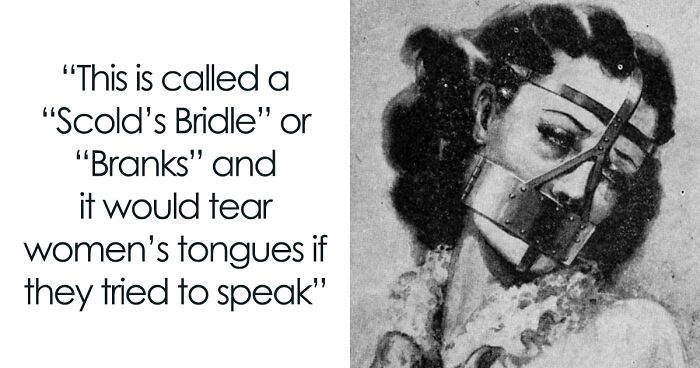
Woman Explains Why Gossiping Was Stigmatized By Men And Many Agree Her Opinion Has Great Points
Lara Lee Kelly, aka Lanthane Radium, is on a quest to dismantle what she calls deeply engrained misogynistic propaganda. One of her latest targets is gossiping.
In an attempt to rehabilitate it, the 20-year-old returned to the roots of the term and its evolution over time, presenting the findings of her research in a two-part TikTok miniseries. As of this publication, her videos have over 4 million and 350 thousand views. Clearly, people are interested.
Continue scrolling to check out Kelly’s take on gossiping and let us know what you think about it in the comments.
Recently, TikTok user Lanthane Radium posted a two-part TikTok miniseries on gossiping
@lanthane_radium#greenscreen follow me here & on insta to unlearn some more stuff the patriarchy has taught us! Pt. 2 is up!♬ original sound – Lara Kelly
And the videos already have a combined 4.3 million views
@lanthane_radium#greenscreen Pt. 2! follow me here & on insta to unlearn some more stuff the patriarchy has taught us!♬ original sound – Lara Kelly
Image credits: Rose-Aimée Bélanger
According to Art Public Montreal, Rose-Aimée Bélanger’s inspiration comes “from the simple moment of everyday life. In her feminine sculptures, her ’rounds’ as she likes to call them, the expression of the eyes is essential to their understanding and appreciation. The emotions are amplified by the sensuality of the curves.”
Les Chuchoteuses is a 2002 bronze sculpture depicting three women, completely absorbed by their conversation. The work was installed as part of an initiative to highlight some of Old Montreal’s forgotten spaces.
The earliest known use of this creepy contraption was in Scotland in the 16th-century to punish and humiliate women who were labeled as scolds or nags.
The Houghton Library at Harvard University claims it “was usually an iron muzzle within an iron framework that would go around the head along with a bridle-bit that would go in the mouth and press down on the tongue- thus effectively silencing the offender.”
Though some sources indicate that this was just a punishment for women, the Burgh Records of Scotland’s major towns reveal that the branks were at times used on men as well: “Patrick Pratt sall sit … bound to the croce of this burgh, in the brankis lockit” (1591 Aberd. B Rec. II. 71) / “He shall be put in the branks be the space of xxiiij houres thairafter” (1559 (c 1650) Dundee B. Laws 19.)
Image credits: Ben Healy
As Sophia Gottfried pointed out in TIME, people usually think of gossip as synonymous with malicious rumors, put-downs, or the breathless propagation of a tabloid scoop. Researchers, however, often define it more broadly.
For example, Megan Robbins, an assistant professor of psychology at The University of California, Riverside, calls it “talking about people who aren’t present.”
“It’s something that comes very naturally to us.” Robbins says gossiping is an integral part of conversation, information sharing, and even community building.
In a 2019 meta-analysis published in the journal Social Psychological and Personality Science, Robbins and her colleague found that, of the 52 minutes a day on average the 467 subjects spent gossiping, three-quarters of that gossip was actually neutral.
One subject, for instance, spoke about someone who was watching a lot of movies to stay current. “It was kind of boring,” Robbins explains, “not salacious and negative” at all.
But negative gossip was twice as prevalent as positive. The results also revealed that younger people engage in more negative gossip than older adults.
Gossip was overwhelmingly about an acquaintance and not a celebrity.
As you might think, extroverts tend to gossip far more frequently than introverts.
Image credits: Anna Sheffer
Image credits: lanthane_radium
Here’s what people said after watching the videos
Gotta say, I disagree with this post. Gossip can have terrible consequences, because it can create and reinforce social stigma and exclusion. There is also nothing on here that says the gossip is always truthful--it isn't. I've suffered consequences in my community, family and place of work because of gossip, a lot of which was absolute fiction. It is destructive, not empowering. And it's not exclusive to women, so let's not turn it into female empowerment.
I am with you; calling bullshit on this post. My wife worked in an office about 95% women, and it was a toxic space with gossip and lies making life hell for her and others. She has worked in a number of offices, and not all were bad; just that a few nasty folks can take 'coffee talk' or 'water cooler scuttlebutt' and turn it into 'Mean Girls'. This was in predominantly female work spaces. Where she worked in predominantly male groups, this NEVER occurred.
Load More Replies...I think the main difference that people are ignoring is that, because of the negative connotations, people only ever refer to gossip when it is negative backbiting. When people talk to others and are not cutting other people down or spreading rumors it is called "talking" or perhaps "having a conversation". Language changes over time. Perhaps there was misogyny at the root of the word (like hysterical), but it can now be applied to anyone and will be viewed negatively. At the risk of being downvoted, is the word gossip really something that needs reclaiming?
I wouldn't say people only refer to something as "gossip" if it is negative. If someone were to say "Oh, did you hear that Nancy has a new boyfriend? I head he works down at the hardware store" "you mean Jimmy? Don't his parents own that store? I've heard rumors that the father is constantly yelling at the poor kid" and then the conversation continued like that for a while, it would be considered gossip.
Load More Replies...Men gossip just as much as women, if not more. How do I know? Most of my life I've worked in engineering companies where almost all of my coworkers were male.
Engineer here, I totally agree. I work in an office where men are the majority. The men I work with are pretty catty and vicious. This not a women's issue, it's a workplace issue esp with promotions and bonuses are at stake.
Load More Replies...Even the word "gossip" has historical meaning: It's a contraction of "Godsib (God sibling), women close enough to be called 'sisters' regardless of blood relation.
The etymology of gossip indicates it was originally "talk between kin/close-bonded people". What happens is, people fear the passing on of their own negative information, and they try to stigmatize gossip b/c they don't want their own secrets getting out. Notice: I said PEOPLE. Men, women, martians, whatever.
I think there is a lot of bad press going around, and you people keep bringing it up in public, (to get likes), reminding everyone of the past... making the reader re-live the horrors their ancestors endured. We live in a global enlightened society now, so stop quoting historical facts from hundreds of years ago and start publicising the good things that are happening in society today, and perhaps your hopes for the future, and why? This article has done more to reinforce the negative connotations of male dominance in history... we need to move forward, in a similar way to the African zeitgeist of stopping constantly reliving slavery, and starting focusing on the good and positive efforts we are making in the global society of today.
Worked most of my adult life in a man's trade and this is just my observation. Men gossip as much as women do . But we women, have been conditioned through the centuries, to hate each other, to * knock them down before they knock you down* because men have always had the power. And the thought of losing that power, scares them. Need proof? Re-read the article again. Once we rid ourselves of the notion that women are foul tongued evil creatures and learn to raise each other up, empower each other, support each other and not fear the success of another woman, then, and only then, will the stigma of *gossiper* be put to rest. Oh, and yes, men LOVE spreading the dirt on each other and they play by a totally different set of rules when it comes to climbing the ladder.
Read, learn, experiment and share your knowledge with others, DON'T TALK BEHIND PEOPLE'S BACK! It's just one SH-TTY ATTITUDE you can gain. Imagine people talking sh-t about you right behind your back because it's supposed to have its benefits, screw that. Just because people read about something and post it on TikTok it doesn't make them psychologists or geniuses. Whatever people say, I disagree with this post.
Whatever the origins are, I work in a primarily all woman field and I'm sorry but 85% of them lie, throw shade, spread rumors, and put each other against one another for personal gain or just for fun. Most of them aren't even interested in talking like adults, they just run to the first person they can get in their side. Men didn't villanize gossip, women know how to be bitches and manipulate the system. Be a little accountable and stop blaming men for calling you on shitty behavior
If you think men don't do that, you're dreaming. I've worked in mostly-male companies all my life and they definitely backstab and gossip just as much as or more than women do.
Load More Replies...I know a person that continually invents malicious gossip just for fun. She is really a nasty Peron pretending to be a friend in most cases.
Hey guys, today we're gonna have a girl-huddle and I'm gonna fabricate a narrative on the spot based on nothing that explains how women don't gossip but when they do it can only ever be super wholesome and in fact it's all men, always, everything and every time, no matter what the issue is but especially when it's sexism, and everything's sexism, except when it's females doing it. Or gay people. Unless they're men. Women being sexist doesn't compute. Trust me, I know. I'm female. Can't wait 'til I hit puberty! gRiL PoWEr!
I call bullshit woman gossip like f**k about each other and most of the time backstabbing bitching s**t too where I'm from anyway and most men usually say it to your face if they have problem with you it's waste of time beating round the bush running your mouth about somebody behind their back there's a saying here "don't stab in the back stab them in the face" gtfoh with this notion on positive gossiping b.s and how it's "MANS" fault why it's stigmatised as is
I don't care if done by men or women, but gossiping, in the sense of talking bad about someone in their back, is toxic and should not be accepted
If you paid attention to the article you would know that is not the original meaning but a meaning assigned when women threatened male power
Load More Replies...The problem with gossiping is that it frequently is confused with bullying. Most bully campaigns feature a very strong gossip component in which the victim is talked and lied about and their reputation is degraded to the point it is a social taboo to talk to them/befriend them. Worse, it may convince the victim that not only do people mistreat them, but that they are right to inflict abuse upon the victim.
"small minds discuss people, average minds discuss events, great minds discuss ideas." I've been target of trash talk by people I don't even know but it went all around the place I more or less regularly went out to. I don't give a flying f**k if this bs brought these gabbling liars together. Promoting this crappy behavior is nothing I agree with and it's awfully weak.
Discussing people is important for developing a community, something we lack in this modern age. The fact that we are told not to means that "nice" people stopped doing it (because they were asked to stop), where as "nasty" people still do it (because they don't care what they were asked to do). So if only nasty people gossip, then gossip will always be nasty.
Load More Replies...Men havent said anything about gossip in quite some time, so I think this lady should one of those traps on herself. Nobody needs to be embarassed with their personal life being exposed. I try hard to not gossip, but have nobody to gossip about anyway, and if someone says something to me I don't pass it along if it is personal.
It was for both nagging and gossip. It was a way for men to violently control women's speech.
Load More Replies...if youre born a man you are free to do whatever and not get blame. if your born a woman, 3/4 of everything in the world is not allowed for women. They call women evil or etc but they made a contraption do cut their tongues if they tried to talk. if youre a woman, welcome to suffering and unequal rights for eternity. its so bad that if abuse happens to men theyre not gonna believe u bc abuse to women is so common they wont believe u. An example of this is johnny depp
Yeah, back in the day there were abuses, but gossip today in our society is definitely a toxic thing.
The whole post starts from the idea that gossiping is something that women did, and men didn't. [REFERENCE NEEDED.] [Hint: There's no historical evidence; St Paul the Misogynist has as usual a few, but that says more about him than about women.]
Before you break a fingernail typing with rage to refute my other JK NBT comment about gossip, let me add that the men who do this are just as badly in the wrong and just as guilty. Men usually don't get on the phone for a Tuesday night gossip-fest with their BFF, but they do perform the majority of the unfair work evaluations out there with the same flaws as mentioned before. These include never getting the whole story or both sides of the story when a problem comes up, using an evaluation for vindictive retaliation, using it for domination & control, and private evaluations where the managers get together in a meeting and just rip & tear down the workers with contempt. This is a witch-hunt when the victim is not allowed to defend himself or face his accusers. Senior managers will not allow this to go on in a well-managed company since it destroys morale and causes unnecessary turnover of qualified, competent staff. Nobody who is good at what they do will put up with this for long.
Seriously? Bonding at a shared dislike of someone else is not a good thing.
I agree that gossip was tarnished by propaganda to silence women, but showing the "Scold's bridle" is a bit extreme for making this point. There were brutally inhumane punishments for everything back then... speaking out against the church (even vaguely), or for being poor, or simply because someone in power didn't like you and wanted to frame you.
Guess which gender got to wear them? It is right on point because it is all about controlling women's speech
Load More Replies...In my opinion, the stereotype that women gossip more than men do is accurate. Women are not flawless. On the flip side, men tend to bottle up their feelings when talking to their friends. This bottling up can lead to depression and even suicide. Men are also flawed. Rather than blaming men for stigmatising gossip, we could try to deal with the issue of the harm that gossiping causes.
I always find the term “nag” sexist as it is generally used when referring to women to trivialise them, as the term “Karen” is being used in more recent times. It makes a woman’s opinion be seen in a negative manner and diminishes the voice of women. I do love a good juicy gossip though.
I would encourage you to read the stories and discriptions of the behavior of the people who are called "Karen" or "Kevin" (the male counterpart). This should show that there is a significant difference between people stating an opinion and using their voice, and the entitlement and disproportionate elitist sociale interactions they have with others (e.g. treating others as servents/tools that should devote their time only to them).
Load More Replies...Seriously...........Is this a joke???? Next thing you know they'll be saying Biden is president!!!!!!!
She's got it backwards. The goal was to punish & discourage the vicious, destructive kind of gossip, not the harmless kind. That's just chatting. There's a reason it was called a "scold's bridle". A scold was a woman with a caustic, bitter tongue. We all know women like that, so trying to suggest this was all "misogyny" is just foolish. Women aren't perfect by default, just because we're women. We have faults, and this is one of the more common ones.
@Nikki, to some people, no gossip was or *is* "harmless". There are men in the world whose women must obey every single command, and that includes not even whispering to other women. It's within individual homes, within societies, within subcultures, within *families*. My dad was one.
Load More Replies...She makes a good point about men stigmatising gossip. Men are also responsible for climate change, airplane crashes, mosquito bites, and toe-stubbing.
You forgot to write 'notallmen' and 'libtard' I think? You're only stirring the pot half-heartedly today ^-^ uwu
Load More Replies...Gotta say, I disagree with this post. Gossip can have terrible consequences, because it can create and reinforce social stigma and exclusion. There is also nothing on here that says the gossip is always truthful--it isn't. I've suffered consequences in my community, family and place of work because of gossip, a lot of which was absolute fiction. It is destructive, not empowering. And it's not exclusive to women, so let's not turn it into female empowerment.
I am with you; calling bullshit on this post. My wife worked in an office about 95% women, and it was a toxic space with gossip and lies making life hell for her and others. She has worked in a number of offices, and not all were bad; just that a few nasty folks can take 'coffee talk' or 'water cooler scuttlebutt' and turn it into 'Mean Girls'. This was in predominantly female work spaces. Where she worked in predominantly male groups, this NEVER occurred.
Load More Replies...I think the main difference that people are ignoring is that, because of the negative connotations, people only ever refer to gossip when it is negative backbiting. When people talk to others and are not cutting other people down or spreading rumors it is called "talking" or perhaps "having a conversation". Language changes over time. Perhaps there was misogyny at the root of the word (like hysterical), but it can now be applied to anyone and will be viewed negatively. At the risk of being downvoted, is the word gossip really something that needs reclaiming?
I wouldn't say people only refer to something as "gossip" if it is negative. If someone were to say "Oh, did you hear that Nancy has a new boyfriend? I head he works down at the hardware store" "you mean Jimmy? Don't his parents own that store? I've heard rumors that the father is constantly yelling at the poor kid" and then the conversation continued like that for a while, it would be considered gossip.
Load More Replies...Men gossip just as much as women, if not more. How do I know? Most of my life I've worked in engineering companies where almost all of my coworkers were male.
Engineer here, I totally agree. I work in an office where men are the majority. The men I work with are pretty catty and vicious. This not a women's issue, it's a workplace issue esp with promotions and bonuses are at stake.
Load More Replies...Even the word "gossip" has historical meaning: It's a contraction of "Godsib (God sibling), women close enough to be called 'sisters' regardless of blood relation.
The etymology of gossip indicates it was originally "talk between kin/close-bonded people". What happens is, people fear the passing on of their own negative information, and they try to stigmatize gossip b/c they don't want their own secrets getting out. Notice: I said PEOPLE. Men, women, martians, whatever.
I think there is a lot of bad press going around, and you people keep bringing it up in public, (to get likes), reminding everyone of the past... making the reader re-live the horrors their ancestors endured. We live in a global enlightened society now, so stop quoting historical facts from hundreds of years ago and start publicising the good things that are happening in society today, and perhaps your hopes for the future, and why? This article has done more to reinforce the negative connotations of male dominance in history... we need to move forward, in a similar way to the African zeitgeist of stopping constantly reliving slavery, and starting focusing on the good and positive efforts we are making in the global society of today.
Worked most of my adult life in a man's trade and this is just my observation. Men gossip as much as women do . But we women, have been conditioned through the centuries, to hate each other, to * knock them down before they knock you down* because men have always had the power. And the thought of losing that power, scares them. Need proof? Re-read the article again. Once we rid ourselves of the notion that women are foul tongued evil creatures and learn to raise each other up, empower each other, support each other and not fear the success of another woman, then, and only then, will the stigma of *gossiper* be put to rest. Oh, and yes, men LOVE spreading the dirt on each other and they play by a totally different set of rules when it comes to climbing the ladder.
Read, learn, experiment and share your knowledge with others, DON'T TALK BEHIND PEOPLE'S BACK! It's just one SH-TTY ATTITUDE you can gain. Imagine people talking sh-t about you right behind your back because it's supposed to have its benefits, screw that. Just because people read about something and post it on TikTok it doesn't make them psychologists or geniuses. Whatever people say, I disagree with this post.
Whatever the origins are, I work in a primarily all woman field and I'm sorry but 85% of them lie, throw shade, spread rumors, and put each other against one another for personal gain or just for fun. Most of them aren't even interested in talking like adults, they just run to the first person they can get in their side. Men didn't villanize gossip, women know how to be bitches and manipulate the system. Be a little accountable and stop blaming men for calling you on shitty behavior
If you think men don't do that, you're dreaming. I've worked in mostly-male companies all my life and they definitely backstab and gossip just as much as or more than women do.
Load More Replies...I know a person that continually invents malicious gossip just for fun. She is really a nasty Peron pretending to be a friend in most cases.
Hey guys, today we're gonna have a girl-huddle and I'm gonna fabricate a narrative on the spot based on nothing that explains how women don't gossip but when they do it can only ever be super wholesome and in fact it's all men, always, everything and every time, no matter what the issue is but especially when it's sexism, and everything's sexism, except when it's females doing it. Or gay people. Unless they're men. Women being sexist doesn't compute. Trust me, I know. I'm female. Can't wait 'til I hit puberty! gRiL PoWEr!
I call bullshit woman gossip like f**k about each other and most of the time backstabbing bitching s**t too where I'm from anyway and most men usually say it to your face if they have problem with you it's waste of time beating round the bush running your mouth about somebody behind their back there's a saying here "don't stab in the back stab them in the face" gtfoh with this notion on positive gossiping b.s and how it's "MANS" fault why it's stigmatised as is
I don't care if done by men or women, but gossiping, in the sense of talking bad about someone in their back, is toxic and should not be accepted
If you paid attention to the article you would know that is not the original meaning but a meaning assigned when women threatened male power
Load More Replies...The problem with gossiping is that it frequently is confused with bullying. Most bully campaigns feature a very strong gossip component in which the victim is talked and lied about and their reputation is degraded to the point it is a social taboo to talk to them/befriend them. Worse, it may convince the victim that not only do people mistreat them, but that they are right to inflict abuse upon the victim.
"small minds discuss people, average minds discuss events, great minds discuss ideas." I've been target of trash talk by people I don't even know but it went all around the place I more or less regularly went out to. I don't give a flying f**k if this bs brought these gabbling liars together. Promoting this crappy behavior is nothing I agree with and it's awfully weak.
Discussing people is important for developing a community, something we lack in this modern age. The fact that we are told not to means that "nice" people stopped doing it (because they were asked to stop), where as "nasty" people still do it (because they don't care what they were asked to do). So if only nasty people gossip, then gossip will always be nasty.
Load More Replies...Men havent said anything about gossip in quite some time, so I think this lady should one of those traps on herself. Nobody needs to be embarassed with their personal life being exposed. I try hard to not gossip, but have nobody to gossip about anyway, and if someone says something to me I don't pass it along if it is personal.
It was for both nagging and gossip. It was a way for men to violently control women's speech.
Load More Replies...if youre born a man you are free to do whatever and not get blame. if your born a woman, 3/4 of everything in the world is not allowed for women. They call women evil or etc but they made a contraption do cut their tongues if they tried to talk. if youre a woman, welcome to suffering and unequal rights for eternity. its so bad that if abuse happens to men theyre not gonna believe u bc abuse to women is so common they wont believe u. An example of this is johnny depp
Yeah, back in the day there were abuses, but gossip today in our society is definitely a toxic thing.
The whole post starts from the idea that gossiping is something that women did, and men didn't. [REFERENCE NEEDED.] [Hint: There's no historical evidence; St Paul the Misogynist has as usual a few, but that says more about him than about women.]
Before you break a fingernail typing with rage to refute my other JK NBT comment about gossip, let me add that the men who do this are just as badly in the wrong and just as guilty. Men usually don't get on the phone for a Tuesday night gossip-fest with their BFF, but they do perform the majority of the unfair work evaluations out there with the same flaws as mentioned before. These include never getting the whole story or both sides of the story when a problem comes up, using an evaluation for vindictive retaliation, using it for domination & control, and private evaluations where the managers get together in a meeting and just rip & tear down the workers with contempt. This is a witch-hunt when the victim is not allowed to defend himself or face his accusers. Senior managers will not allow this to go on in a well-managed company since it destroys morale and causes unnecessary turnover of qualified, competent staff. Nobody who is good at what they do will put up with this for long.
Seriously? Bonding at a shared dislike of someone else is not a good thing.
I agree that gossip was tarnished by propaganda to silence women, but showing the "Scold's bridle" is a bit extreme for making this point. There were brutally inhumane punishments for everything back then... speaking out against the church (even vaguely), or for being poor, or simply because someone in power didn't like you and wanted to frame you.
Guess which gender got to wear them? It is right on point because it is all about controlling women's speech
Load More Replies...In my opinion, the stereotype that women gossip more than men do is accurate. Women are not flawless. On the flip side, men tend to bottle up their feelings when talking to their friends. This bottling up can lead to depression and even suicide. Men are also flawed. Rather than blaming men for stigmatising gossip, we could try to deal with the issue of the harm that gossiping causes.
I always find the term “nag” sexist as it is generally used when referring to women to trivialise them, as the term “Karen” is being used in more recent times. It makes a woman’s opinion be seen in a negative manner and diminishes the voice of women. I do love a good juicy gossip though.
I would encourage you to read the stories and discriptions of the behavior of the people who are called "Karen" or "Kevin" (the male counterpart). This should show that there is a significant difference between people stating an opinion and using their voice, and the entitlement and disproportionate elitist sociale interactions they have with others (e.g. treating others as servents/tools that should devote their time only to them).
Load More Replies...Seriously...........Is this a joke???? Next thing you know they'll be saying Biden is president!!!!!!!
She's got it backwards. The goal was to punish & discourage the vicious, destructive kind of gossip, not the harmless kind. That's just chatting. There's a reason it was called a "scold's bridle". A scold was a woman with a caustic, bitter tongue. We all know women like that, so trying to suggest this was all "misogyny" is just foolish. Women aren't perfect by default, just because we're women. We have faults, and this is one of the more common ones.
@Nikki, to some people, no gossip was or *is* "harmless". There are men in the world whose women must obey every single command, and that includes not even whispering to other women. It's within individual homes, within societies, within subcultures, within *families*. My dad was one.
Load More Replies...She makes a good point about men stigmatising gossip. Men are also responsible for climate change, airplane crashes, mosquito bites, and toe-stubbing.
You forgot to write 'notallmen' and 'libtard' I think? You're only stirring the pot half-heartedly today ^-^ uwu
Load More Replies...

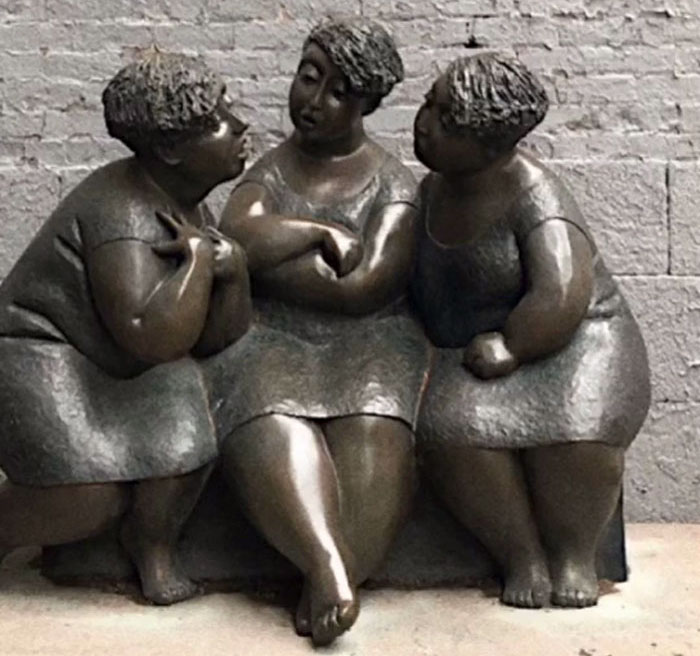



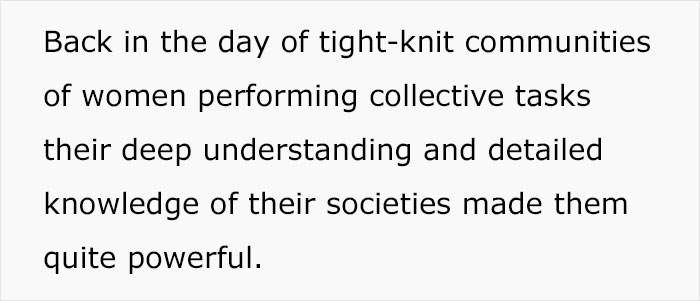




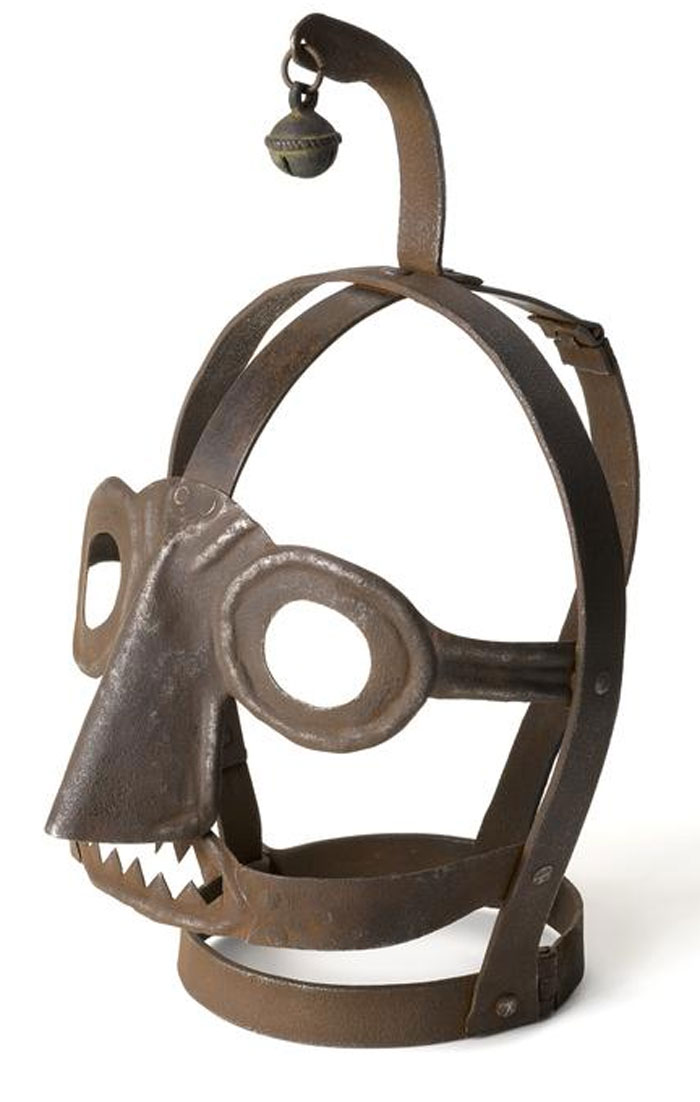










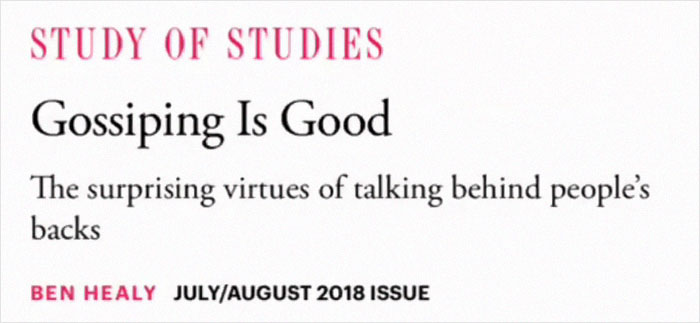

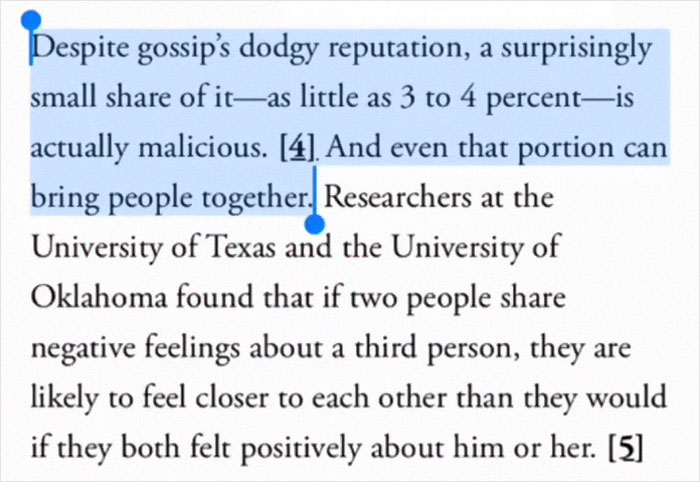

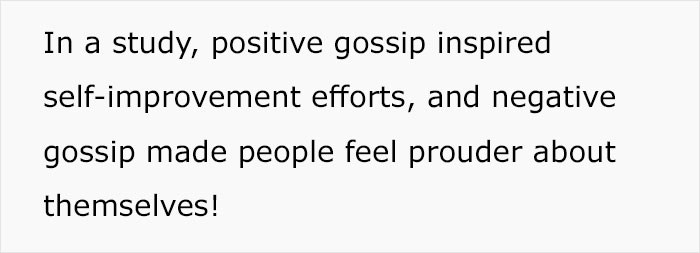

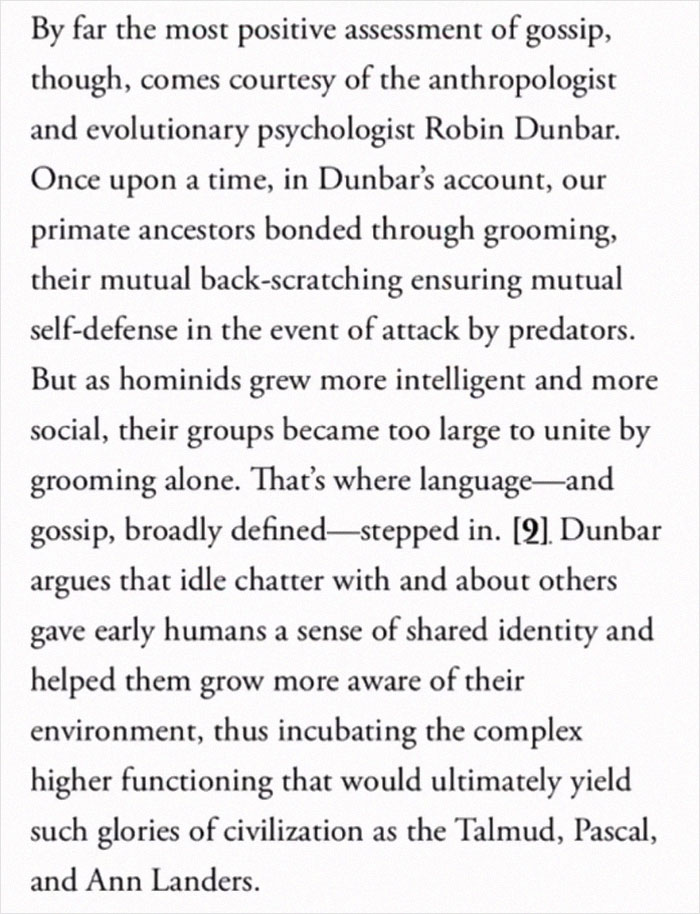


















38
111